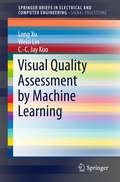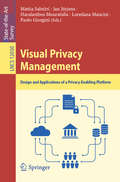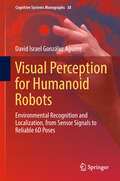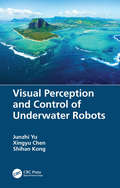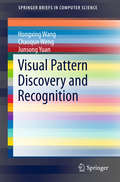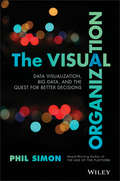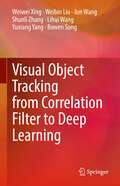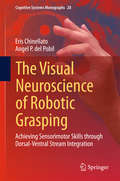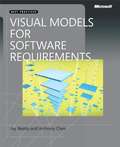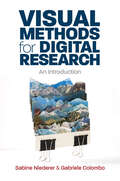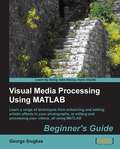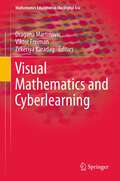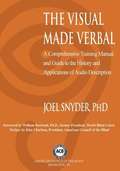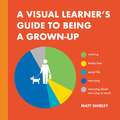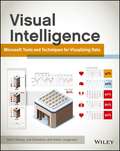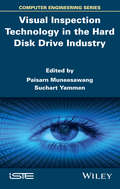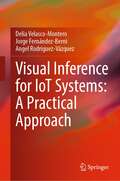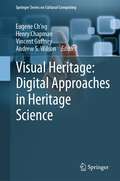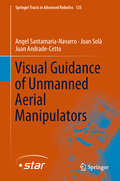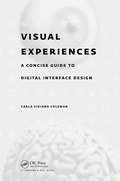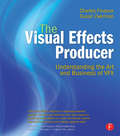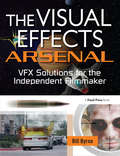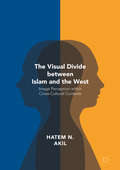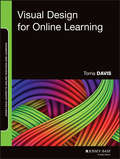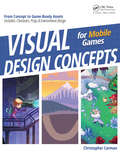- Table View
- List View
Visual Quality Assessment by Machine Learning
by Long Xu Weisi Lin C.-C. Jay KuoThe book encompasses the state-of-the-art visual quality assessment (VQA) and learning based visual quality assessment (LB-VQA) by providing a comprehensive overview of the existing relevant methods. It delivers the readers the basic knowledge, systematic overview and new development of VQA. It also encompasses the preliminary knowledge of Machine Learning (ML) to VQA tasks and newly developed ML techniques for the purpose. Hence, firstly, it is particularly helpful to the beginner-readers (including research students) to enter into VQA field in general and LB-VQA one in particular. Secondly, new development in VQA and LB-VQA particularly are detailed in this book, which will give peer researchers and engineers new insights in VQA.
Visual Privacy Management: Design and Applications of a Privacy-Enabling Platform (Lecture Notes in Computer Science #12030)
by Haralambos Mouratidis Paolo Giorgini Mattia Salnitri Jan Jürgens Loredana ManciniPrivacy is a burden for most organizations, the more complex and wider an organization is, the harder to manage and enforce privacy is.GDPR and other regulations on privacy impose strict constraints that must be coherently enforced, considering also privacy needs of organization and their users. Furthermore, organizations should allow their users to express their privacy needs easily, even when the process that manages users' data is complex and involves multiple organizations.Many research work consider the problem using simplistic examples, with solutions proposed that never actually touch pragmatic problems of real, large organizations, with thousands of users and terabytes of personal and sensitive data.This book faces the privacy management problem targeting actual large organizations, such as public administrations, including stakeholders in the process of definition of the solution and evaluating the results with its actual integration in four large organizations. The contribution of this book is twofold: a privacy platform that can be customized and used to manage privacy in large organizations; and the process for the design of such a platform, from a state-of-the-art survey on privacy regulations, through the definition of its requirements, its design and its architecture, until the evaluation of the platform.
Visual Perception for Humanoid Robots: Environmental Recognition and Localization, from Sensor Signals to Reliable 6D Poses (Cognitive Systems Monographs #38)
by David Israel González AguirreThis book provides an overview of model-based environmental visual perception for humanoid robots. The visual perception of a humanoid robot creates a bidirectional bridge connecting sensor signals with internal representations of environmental objects. The objective of such perception systems is to answer two fundamental questions: What & where is it? To answer these questions using a sensor-to-representation bridge, coordinated processes are conducted to extract and exploit cues matching robot’s mental representations to physical entities. These include sensor & actuator modeling, calibration, filtering, and feature extraction for state estimation. This book discusses the following topics in depth: • Active Sensing: Robust probabilistic methods for optimal, high dynamic range image acquisition are suitable for use with inexpensive cameras. This enables ideal sensing in arbitrary environmental conditions encountered in human-centric spaces. The book quantitatively shows the importance of equipping robots with dependable visual sensing. • Feature Extraction & Recognition: Parameter-free, edge extraction methods based on structural graphs enable the representation of geometric primitives effectively and efficiently. This is done by eccentricity segmentation providing excellent recognition even on noisy & low-resolution images. Stereoscopic vision, Euclidean metric and graph-shape descriptors are shown to be powerful mechanisms for difficult recognition tasks. • Global Self-Localization & Depth Uncertainty Learning: Simultaneous feature matching for global localization and 6D self-pose estimation are addressed by a novel geometric and probabilistic concept using intersection of Gaussian spheres. The path from intuition to the closed-form optimal solution determining the robot location is described, including a supervised learning method for uncertainty depth modeling based on extensive ground-truth training data from a motion capture system.The methods and experiments are presented in self-contained chapters with comparisons and the state of the art. The algorithms were implemented and empirically evaluated on two humanoid robots: ARMAR III-A & B. The excellent robustness, performance and derived results received an award at the IEEE conference on humanoid robots and the contributions have been utilized for numerous visual manipulation tasks with demonstration at distinguished venues such as ICRA, CeBIT, IAS, and Automatica.
Visual Perception and Control of Underwater Robots
by Junzhi Yu Xingyu Chen Shihan KongVisual Perception and Control of Underwater Robots covers theories and applications from aquatic visual perception and underwater robotics. Within the framework of visual perception for underwater operations, image restoration, binocular measurement, and object detection are addressed. More specifically, the book includes adversarial critic learning for visual restoration, NSGA-II-based calibration for binocular measurement, prior knowledge refinement for object detection, analysis of temporal detection performance, as well as the effect of the aquatic data domain on object detection. With the aid of visual perception technologies, two up-to-date underwater robot systems are demonstrated. The first system focuses on underwater robotic operation for the task of object collection in the sea. The second is an untethered biomimetic robotic fish with a camera stabilizer, its control methods based on visual tracking. The authors provide a self-contained and comprehensive guide to understand underwater visual perception and control. Bridging the gap between theory and practice in underwater vision, the book features implementable algorithms, numerical examples, and tests, where codes are publicly available. Additionally, the mainstream technologies covered in the book include deep learning, adversarial learning, evolutionary computation, robust control, and underwater bionics. Researchers, senior undergraduate and graduate students, and engineers dealing with underwater visual perception and control will benefit from this work.
Visual Pattern Discovery and Recognition
by Hongxing Wang Chaoqun Weng Junsong YuanThis book presents a systematic study of visual pattern discovery, from unsupervised to semi-supervised manner approaches, and from dealing with a single feature to multiple types of features. Furthermore, it discusses the potential applications of discovering visual patterns for visual data analytics, including visual search, object and scene recognition. It is intended as a reference book for advanced undergraduates or postgraduate students who are interested in visual data analytics, enabling them to quickly access the research world and acquire a systematic methodology rather than a few isolated techniques to analyze visual data with large variations. It is also inspiring for researchers working in computer vision and pattern recognition fields. Basic knowledge of linear algebra, computer vision and pattern recognition would be helpful to readers.
The Visual Organization
by Phil SimonThe era of Big Data as arrived, and most organizations are woefully unprepared. Slowly, many are discovering that stalwarts like Excel spreadsheets, KPIs, standard reports, and even traditional business intelligence tools aren't sufficient. These old standbys can't begin to handle today's increasing streams, volumes, and types of data. Amidst all of the chaos, though, a new type of organization is emerging. In The Visual Organization, award-winning author and technology expert Phil Simon looks at how an increasingly number of organizations are embracing new dataviz tools and, more important, a new mind-set based upon data discovery and exploration. Simon adroitly shows how Amazon, Apple, Facebook, Google, Twitter, and other tech heavyweights use powerful data visualization tools to garner fascinating insights into their businesses. But make no mistake: these companies are hardly alone. Organizations of all types, industries, sizes are representing their data in new and amazing ways. As a result, they are asking better questions and making better business decisions.Rife with real-world examples and case studies, The Visual Organization is a full-color tour-de-force.
Visual Object Tracking from Correlation Filter to Deep Learning
by Weiwei Xing Weibin Liu Jun Wang Shunli Zhang Lihui Wang Yuxiang Yang Bowen SongThe book focuses on visual object tracking systems and approaches based on correlation filter and deep learning. Both foundations and implementations have been addressed. The algorithm, system design and performance evaluation have been explored for three kinds of tracking methods including correlation filter based methods, correlation filter with deep feature based methods, and deep learning based methods. Firstly, context aware and multi-scale strategy are presented in correlation filter based trackers; then, long-short term correlation filter, context aware correlation filter and auxiliary relocation in SiamFC framework are proposed for combining correlation filter and deep learning in visual object tracking; finally, improvements in deep learning based trackers including Siamese network, GAN and reinforcement learning are designed. The goal of this book is to bring, in a timely fashion, the latest advances and developments in visual object tracking, especially correlation filter and deep learning based methods, which is particularly suited for readers who are interested in the research and technology innovation in visual object tracking and related fields.
The Visual Neuroscience of Robotic Grasping
by Eris Chinellato Angel P. PobilThis book presents interdisciplinary research that pursues the mutual enrichment of neuroscience and robotics. Building on experimental work, and on the wealth of literature regarding the two cortical pathways of visual processing - the dorsal and ventral streams - we define and implement, computationally and on a real robot, a functional model of the brain areas involved in vision-based grasping actions. Grasping in robotics is largely an unsolved problem, and we show how the bio-inspired approach is successful in dealing with some fundamental issues of the task. Our robotic system can safely perform grasping actions on different unmodeled objects, denoting especially reliable visual and visuomotor skills. The computational model and the robotic experiments help in validating theories on the mechanisms employed by the brain areas more directly involved in grasping actions. This book offers new insights and research hypotheses regarding such mechanisms, especially for what concerns the interaction between the dorsal and ventral streams. Moreover, it helps in establishing a common research framework for neuroscientists and roboticists regarding research on brain functions.
Visual Models for Software Requirements
by Anthony Chen Joy BeattyApply best practices for capturing, analyzing, and implementing software requirements through visual models--and deliver better results for your business. The authors--experts in eliciting and visualizing requirements--walk you through a simple but comprehensive language of visual models that has been used on hundreds of real-world, large-scale projects. Build your fluency with core concepts--and gain essential, scenario-based context and implementation advice--as you progress through each chapter. Transcend the limitations of text-based requirements data using visual models that more rigorously identify, capture, and validate requirements Get real-world guidance on best ways to use visual models--how and when, and ways to combine them for best project outcomes Practice the book's concepts as you work through chapters Change your focus from writing a good requirement to ensuring a complete system
Visual Methods for Digital Research: An Introduction
by Sabine Niederer Gabriele ColomboOver the last decade, images have become a key feature of digital culture; at the same time, they have made a mark on a wide range of research practices.Visual Methods for Digital Research is the first textbook to bring the fields of visual methods and digital research together. Presenting visual methods for digital and participatory research, the book covers both the application of existing digital methods for image research and new visual methodologies developed specifically for digital research. It encompasses various approaches to studying digital images, including the distant reading of image collections, the close reading of visual vernaculars of social media platforms, and participatory research with visual materials. Offering a theoretical framework illustrated with hands-on techniques, Sabine Niederer and Gabriele Colombo provide compelling examples for studying online images through visual and digital means, and discuss critical data practices such as data feminism and digital methods for social and cultural research.This textbook is an accessible and invaluable guide for students and researchers of digital humanities, social sciences, information and communication design, critical data visualization and digital visual culture.
Visual Media Processing Using Matlab Beginner's Guide
by George SiogkasWritten in a friendly, Beginner's Guide format, showing the user how to use the digital media aspects of Matlab (image, video, sound) in a practical, tutorial-based style.This is great for novice programmers in any language who would like to use Matlab as a tool for their image and video processing needs, and also comes in handy for photographers or video editors with even less programming experience wanting to find an all-in-one tool for their tasks.
Visual Mathematics and Cyberlearning
by Dragana Martinovic Zekeriya Karadag Viktor FreimanThis first book in the series will describe the Net Generation as visual learners who thrive when surrounded with new technologies and whose needs can be met with the technological innovations. These new learners seek novel ways of studying, such as collaborating with peers, multitasking, as well as use of multimedia, the Internet, and other Information and Communication Technologies. Here we present mathematics as a contemporary subject that is engaging, exciting and enlightening in new ways. For example, in the distributed environment of cyber space, mathematics learners play games, watch presentations on YouTube, create Java applets of mathematics simulations and exchange thoughts over the Instant Messaging tool. How should mathematics education resonate with these learners and technological novelties that excite them?
The Visual Made Verbal: A Comprehensive Training Manual and Guide to the History and Applications of Audio Description
by Joel SnyderVerbal descriptions of life have been around for centuries, but the digital age has made access to those descriptions even more important. Dr. Joel Snyder, an audio description pioneer, has created a book and website offering the first overview of the field, including its history, application to a range of genres, description of training techniques and list of resources. Audio description brings the visual world to life, making theater productions, television shows, films, visual art and events accessible to people who are blind or have low vision. Describers employ succinct, vivid, imaginative words to convey visual images those with sight take for granted. Although countries worldwide have taken up the cause, the United States has fallen short on research and institutions to study the field. Dr. Snyder's book helps fill in some of those gaps. "For decades, Joel Snyder has combined his astonishing command of language with his keen attention to detail to create word pictures that stir the mind's eye, especially for patrons of the arts whose physical eyes cannot see. ... His book has been long-awaited and no doubt will become the standard for prospective audio describers around the world." -- Kelsey Marshall, founding director of accessibility, John F. Kennedy Center for the Performing Arts in Washington, D.C. Dr. Joel Snyder is known internationally as one of the world's first "audio describers," a pioneer in the field of audio description: making theater events, museum exhibitions, and media accessible to people who are blind or have low vision. Since 1981, he has introduced audio description techniques in 36 states and D.C. and in 35 countries; he holds a Ph.D. in accessibility-audio description from the Universitat Autonoma de Barcelona. Dr. Snyder's company, Audio Description Associates, LLC (www.audiodescribe.com) uses audio description to enhance a wide range of arts projects including video and film, museum exhibitions and live events, As Director of Described Media for the National Captioning Institute, he supervised the production of description for Sesame Street and dozens of feature films and nationally broadcast television; his descriptions can be heard at Smithsonian Institution exhibits, the Getty Museum, the Albright-Knox Gallery and throughout the country at National Park Service visitor centers. As Director of the American Council of the Blind's Audio Description Project (www.acb.org/adp), Dr. Snyder voiced description for network coverage of President Obama's inauguration in 2009 and 2013 and recently produced the first-ever audio described tour of The White House; the ADP website is the nation's principal provider of information and resources on audio description.
A Visual Learner's Guide to Being a Grown-Up
by Matt ShirleyBased on Matt Shirley's popular Instagram account, this smart and hilarious guide is a collection of tables, lists, and charts for all the visual learners out there striving to be a successful grown-up.We all know the particular pain that comes with having to be an actual adult, whether it's resetting your internet password on ten different sites, yearning for an excuse to get out of the plans your wife made for you months ago, or the anxiety that comes from forcing yourself to work out again.When Matt Shirley became fed up with being a grown-up, he started drawing charts as a more fun and efficient way to cope with his frustrations, and stuck them up on Instagram where they became an instant hit. Packed with over one hundred charts, graphs, diagrams, and infographics—with 50 percent brand-new material—this hilarious collection vows to explain everything you need to know about how to be a grown-up, covering work, family, and friends, to dating, breakups, and more.From explaining the cycle of adulthood to decoding the pros and cons of first dates to understanding the corporate lingo translator, Shirley's charts cut to the core of how to be an adult in the funniest possible way.
Visual Intelligence
by Mark Stacey Joe Salvatore Adam JorgensenGo beyond design concepts and learn to build state-of-the-art visualizationsThe visualization experts at Microsoft's Pragmatic Works have created a full-color, step-by-step guide to building specific types of visualizations. The book thoroughly covers the Microsoft toolset for data analysis and visualization, including Excel, and explores best practices for choosing a data visualization design, selecting tools from the Microsoft stack, and building a dynamic data visualization from start to finish. You'll examine different types of visualizations, their strengths and weaknesses, and when to use each one. Data visualization tools unlock the stories within the data, enabling you to present it in a way that is useful for making business decisionsThis full-color guide introduces data visualization design concepts, then explains the various Microsoft tools used to store and display dataFeatures a detailed discussion of various classes of visualizations, their uses, and the appropriate tools for each Includes practical implementations of various visualizations and best practices for using themCovers out-of-the-box Microsoft tools, custom-developed illustrations and implementations, and code examplesVisual Intelligence: Microsoft Tools and Techniques for Visualizing Data arms you with best practices and the knowledge to choose and build dynamic data visualizations.
Visual Inspection Technology in the Hard Disc Drive Industry
by Suchart Yammen Paisarn MuneesawangA presentation of the use of computer vision systems to control manufacturing processes and product quality in the hard disk drive industry. Visual Inspection Technology in the Hard Disk Drive Industry is an application-oriented book borne out of collaborative research with the world's leading hard disk drive companies. It covers the latest developments and important topics in computer vision technology in hard disk drive manufacturing, as well as offering a glimpse of future technologies.
Visual Inference for IoT Systems: A Practical Approach
by Angel Rodríguez-Vázquez Jorge Fernández-Berni Delia Velasco-MonteroThis book presents a systematic approach to the implementation of Internet of Things (IoT) devices achieving visual inference through deep neural networks. Practical aspects are covered, with a focus on providing guidelines to optimally select hardware and software components as well as network architectures according to prescribed application requirements. The monograph includes a remarkable set of experimental results and functional procedures supporting the theoretical concepts and methodologies introduced. A case study on animal recognition based on smart camera traps is also presented and thoroughly analyzed. In this case study, different system alternatives are explored and a particular realization is completely developed. Illustrations, numerous plots from simulations and experiments, and supporting information in the form of charts and tables make Visual Inference and IoT Systems: A Practical Approach a clear and detailed guide to the topic. It will be of interest to researchers, industrial practitioners, and graduate students in the fields of computer vision and IoT.
Visual Heritage: Digital Approaches in Heritage Science (Springer Series on Cultural Computing)
by Eugene Ch'Ng Vincent Gaffney Henry Chapman Andrew S. WilsonHow we understand our shared and individual heritage, interpret and disseminate that knowledge is increasingly central to contemporary society. The emerging context for such development is the field of heritage science. Inherently interdisciplinary, and involving both the Arts and Humanities, engineering, conservation and the digital sciences, the development of heritage science is a driver for change; socially, economically and technically. This book has gathered contributions from leading researchers from across the world and provides a series of themed contributions demonstrating the theoretical, ethical, methodological and technical methods which lie at the heart of heritage science. Archaeology, conservation, museology, the arts, forensic sciences, and heritage management are represented through collaborative research with specialists in applied technologies including object and terrestrial laser scanning, multi-spectral imaging, visualisation, GIS and 3D-printing. Together, the chapters present important case studies to demonstrate the recent advances and best practise within the discipline, highlighting the value of digital transformation across the heritage community that includes objects, monuments, sites and landscapes spanning two million years of natural and cultural history from all over the world. Visual Heritage: Digital Approaches in Heritage Science is aimed at a broad academic and practice-led readership, which extends across many disciplines and will be of considerable value to scholars, practitioners, and students working within heritage and computer science at all levels. The content, which applies heritage science across two million years of cultural history will be appreciated by a general audience, as well as those wishing simply to explore the vast range of potential technical applications across all the disciplines represented in the book.
Visual Guidance of Unmanned Aerial Manipulators (Springer Tracts in Advanced Robotics #125)
by Angel Santamaria-Navarro Joan Solà Juan Andrade-CettoThis monograph covers theoretical and practical aspects of the problem of autonomous guiding of unmanned aerial manipulators using visual information. For the estimation of the vehicle state (position, orientation, velocity, and acceleration), the authors propose a method that relies exclusively on the use of low-cost and highrate sensors together with low-complexity algorithms. This is particularly interesting for applications in which on board computation with low computation power is needed. Another relevant topic covered in this monograph is visual servoing. The authors present an uncalibrated visual servo scheme, capable of estimating at run time, the camera focal length from the observation of a tracked target. The monograph also covers several control techniques, which achieve a number of tasks, such as robot and arm positioning, improve stability and enhance robot arm motions. All methods discussed in this monograph are demonstrated in simulation and through real robot experimentation. The text is appropriate for readers interested in state estimation and control of aerial manipulators, and is a reference book for people who work in mobile robotics research in general.
Visual Experiences: A Concise Guide to Digital Interface Design
by Carla Viviana ColemanVisual Experiences: A Concise Guide to Digital Interface Design provides step-by-step examples to enable readers to create an interface, guiding them from sketching an idea to creating an interactive prototype. This creation of a visual experience is achieved in three steps: thought, design, and interaction. This book focuses on the visual experience of digital interface design from the initial idea to end-user prototype. Key Features Shows how to design visual digital interface experiences: a concise guide to creating successful prototypes without programming. Teaches the whole process of how to sketch, design, and create interactions. Unlike other books, this book does not just give a list of terminologies, but workable examples and methods. Includes a wide range of basic to advanced exercises geared towards professionals and students alike. Includes many illustrations throughout the book, guiding the reader through the process.
The Visual Effects Producer: Understanding the Art and Business of VFX
by Susan Zwerman Charles FinanceFirst published in 2010. Routledge is an imprint of Taylor & Francis, an informa company.
The Visual Effects Arsenal: VFX Solutions for the Independent Filmmaker
by Bill ByrneBuild your VFX arsenal with quick-access, step-by-step instruction on how to create today's hottest digital VFX shots. This essential toolkit provides techniques for creating effects seen in movies such as 300, Spiderman 3, Predator and others, with lessons on how-to:* splatter blood or digitally lop someone's arm off* create a scene with actors running from an explosion* create the "twin effect" (same actor, same location, 2 performances)* produce space-ship dog fightsOrganized in a 'cookbook' style, this allows you to reference a certain effect in the index and immediately access concise instructions to create that effect. Techniques are demonstrated in each of the most popular software tools- After Effects, Final Cut Studio, Photoshop, and Combustion are all covered. Brilliant, 4-color presentation provides inspiration and stimulating visual guidance to the lessons presented, while the downloadable resources contain project media files enabling you to put concepts learned into immediate practice.
The Visual Divide between Islam and the West
by Hatem N. AkilThis book considers the ways in which Muslims view the way they are being viewed, not viewed, or incorrectly viewed, by the West. The book underscores a certain "will-to-visibility" whereby Muslims/ Arabs wish just to be "seen" and to be marked as fellow human beings. The author relates the failure to achieve this visibility to a state of desperation that inextricably and symmetrically ties visibility to violence. When Syrian and Palestinian refugees recently started refusing to be photographed, they clearly ushered the eventual but inevitable collapse of the image and its final futility. The photograph has been completely emptied of its last remaining possibility of signification. The book attempts to engage with questions about the ways in which images are perceived within cross cultural contexts. Why and how do people from different cultural backgrounds view the same image in opposing ways; why do cartoon, photographs, and videos become both the cause and target of bloody political violence - as witnessed recently by the deadly attacks against Charlie Hebdo in France and in the swift military response by the US, Jordan, France, and others to videotaped violence by ISIS.
Visual Design for Online Learning
by Torria DavisUpdate the visual design of your course in pedagogically sound ways Visual Design for Online Learning spotlights the role that visual elements play in the online learning environment. Written for both new and experienced instructors, the book guides you in adding pedagogically relevant visual design elements that contribute to effective learning practices. The text builds upon three conceptual frameworks: active learning, multiple intelligences, and universal design for learning. This resource explores critical issues such as copyright, technology tools, and accessibility and includes examples from top Blackboard practitioners which are applicable to any LMS. Ultimately, the author guides you in developing effective visual elements that will support your teaching goals while reinforcing the learning materials you share with your students. There has been a steady increase of over 10% in online enrollment for higher education institutions since 2002, yet the visual look of online courses has not changed significantly in the last ten years. Adapting to the needs of students within online classes is critical to guiding your students toward success--and the right visual elements can play an integral role in your students' ability to learn and retain the information they need to thrive in their chosen programs. In fact, visual elements have been shown to increase student participation, engagement, and success in an online course. Leverage the best practices employed by exemplary Blackboard practitioners Explore three foundational conceptual frameworks: active learning, multiple intelligences, and universal design for learning Increase student retention and success Visual Design for Online Learning is an essential reference for all online educators--both new and experienced.
Visual Design Concepts For Mobile Games
by Chirstopher P CarmanThis book is geared towards both students as well as professionals who are looking to enter the mobile (tablet/smartphone) and PC (personal computer) industry as concept artists (for both 2D and 3D production pipelines) or 2D production artists (game-ready assets). This book is not specifically focused on game design or game development and is also not a 3D modeling or animation guide. However, certain aspects of game design, game development, and 3D modeling and animation will impact the visual development and art creation process. So, at points throughout we will explore topics such as game engine performance and game mechanics, though at a very high-level, bird's-eye, vantage point and only as they pertain to the visual development of the various assignments throughout this book. Through the completion of the exercises and assignments contained within Visual Development for Web & Mobile Games readers will be guided through the visual development process and execution of a variety of concepts and assets (final game art). This includes categories such as characters, props, and backgrounds, within an isometric design template. The categories themselves will relate more to their function within a very simple game design template than their completed visual representation (e.g., the "big build-able" category could be anything from a town square to a fire breathing dragon as long as it fits within the bare bones parameters of the asset types functionality). The concept, theme, and style of these assets, as well as the world they inhabit, will be completely up to the individual artist. Key Features Weaves knowledge of classic visual development principles and web/mobile game art production practices. Assignments and exercises at the end of every chapter allow the reader to create a game art project from start to finish. Examines both 2D/3D game art pipelines. Includes a companion website with project files, asset downloads & author created video tutorials.
